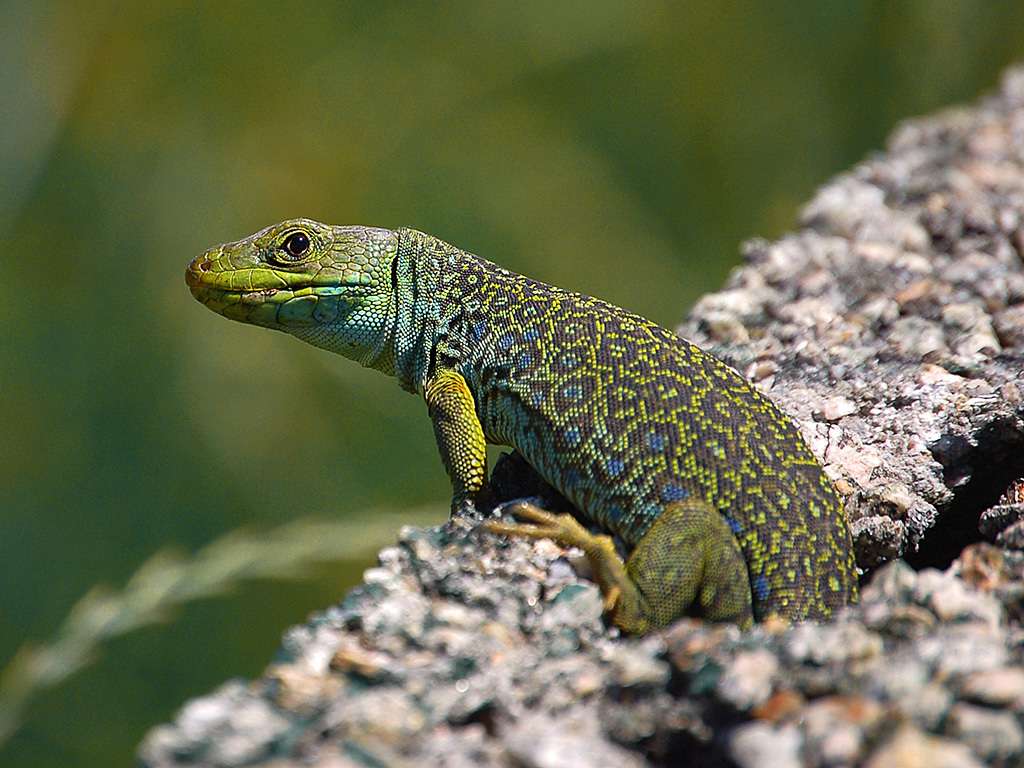
Description:
Scientific name: Timon lepidus
Life span: 17 years
The jewelled lizard (Timon lepidus), often known as the ocellated lizard, is a species of lizard in the Lacertidae family (wall lizards). This lizard is substantial and has a sharp collar. The male bears the typical broad head shape. It has long, curved claws on thick, powerful legs. Typically, the dorsal background color is green, although it can sometimes occasionally be gray or brownish, particularly on the head and tail. This has black stippling applied over top of it, which might create a striking rosette pattern.
Native Region/Habitat
Southwest Europe is home to the Timon lepidus. It is widespread throughout the Iberian Peninsula (Portugal, Spain, Gibraltar), as well as in southwestern Italy and southern France.

Behavior:
The shy yet energetic jewelled lizard spends the most of its time burrowing, sunbathing, or exploring. Jeweled lacertas can be hostile with one another, particularly over food, even though they are rarely aggressive towards humans. To avoid them hurting one another, keep these reptiles in separate enclosures.
Jeweled lizards are nervous and easily stressed. Only handle them when required, and keep their enclosure away from busy, noisy areas. If these lizards feel attacked or terrified, they may bite. Open-mouth breathing, concealment, appetite loss, and dull skin colour are all indications of stress.
Care As a pet/In captivity:
Enclosure size:
This lizard needs a vivarium that is at least 4 feet by 2 feet by 3 feet in size and holds 20 gallons. The lizard has plenty of room to spread out and explore at this size. The vivarium needs to be tall enough to accommodate a thick substrate and climbing apparatus because jewelled lizards like to burrow and occasionally climb. Juveniles should be kept in separate 20-gallon vivariums because they have been known to fight one another. Choose a vivarium with a front opening so you can reach inside without waking the lizard up.
Temperature and Humidity:
These lizards need both hot and cold places in their habitat to maintain a healthy body temperature because they are cold-blooded. The basking region should be between 90 and 95°F, while the cold area should be between 75 and 85°F.
If the UVB lamp isn’t producing enough heat, add a thermostat-controlled heating pad. At night, the enclosure’s temperature must be higher than 72°F. High-quality digital thermometers should be used to monitor temperature levels.
A moderate humidity of 50 to 60% is needed for jewelled lizards. If the humidity falls too low, lightly mist the enclosure with water, and if it rises too high, add ventilation. To determine the humidity levels, use a hygrometer.
Food and Water:
The omnivorous jewelled lacertas must be fed every day since they are driven by food. These lizards mostly consume invertebrates in the wild, such as insects and snails. A diversified food consisting of crickets, super worms, Dubia roaches, snails, silkworms, and occasionally fruit should be provided for captive-bred jewelled lacertas (like strawberries and raspberries).
As much food as the jewelled lacertas can consume in one sitting should be provided. Two freshly hatched crickets should be fed to juveniles three to five times per week. Only purchase insects raised in a lab since those seen in the wild can contain dangerous chemicals. The lizard develops more quickly as it consumes more food.
To promote the lizard’s healthy bone development, include calcium and vitamin D3 supplements in powder form in meals a few times each week.
Table





